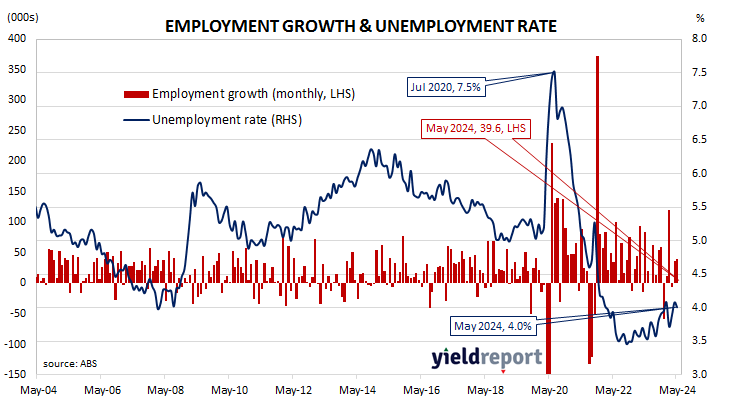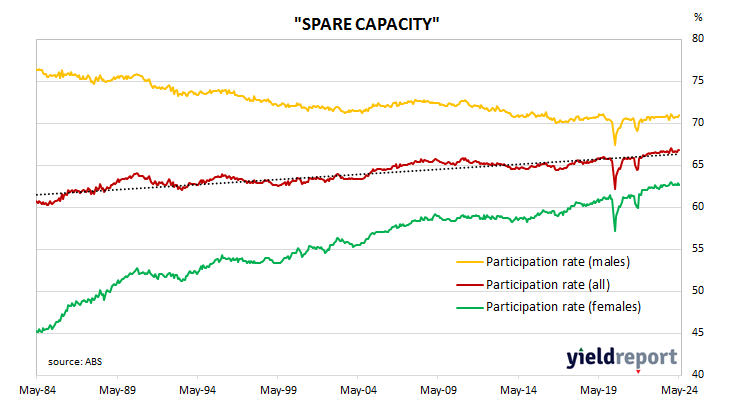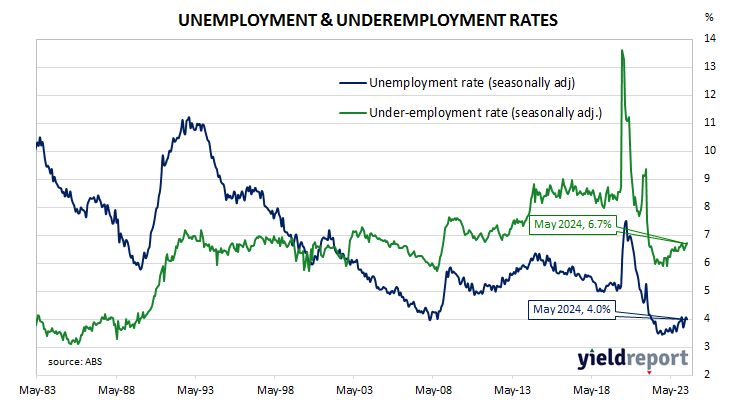Summary: Employment up 39,600 in May, greater than expected; ANZ: labour market continues easing slowly; ACGB yields fall; rate-cut expectations firm; Westpac: employment growth keeping pace with population growth; participation rate steady at 66.8%; jobless rate declines from 4.1% to 4.0%; fewer part-time jobs, more full-time jobs; aggregate work hours down 0.5%; underemployment rate steady at 6.7%.
Australia’s period of falling unemployment came to an end in early 2019 when the jobless rate hit a low of 4.9%. It then averaged around 5.2% through to March 2020, bouncing around in a range from 5.1% to 5.3%. Leading indicators such as ANZ-Indeed’s Job Ads survey and NAB’s capacity utilisation estimate suggested the unemployment rate would rise in the June 2020 quarter and it did so, sharply. The jobless rate peaked in July 2020 but fell below 7% a month later and then trended lower through 2021 and 2022.
The latest Labour force figures have now been released and they indicate the number of people employed in Australia according to ABS definitions increased by 39,600 in May. The result was greater than the 25,000 rise which had been generally expected as well as April’s downwardly-revised rise of 37,400.
“The labour market continues to ease, although the pace of easing is slow,” said ANZ senior economist Blair Chapman. “The unemployment rate is increasing, employment and total hours worked growth is slowing and average hours worked is declining.”
Domestic Treasury bond yields fell on the day, somewhat following the downward movements of US Treasury yields overnight. By the close of business, the 3-year ACGB yield had lost 6bps to 3.89%, the 10-year yield had shed 9bps to 4.20% while the 20-year yield finished 8bps lower at 4.51%.
Expectations regarding rate cuts in the next twelve months firmed by the end of the day. In the cash futures market, contracts implied the cash rate would remain close to the current rate for the next few months and average 4.315% through June and July and 4.325% in August. However, November contracts implied 4.285%, February 2025 contracts implied 4.205% while May 2025 contracts implied 4.08%, 24bps less than the current cash rate.
“Employment growth, while slowing from its peak, has managed to keep pace with population growth and remain slightly firmer than the pre-pandemic norm,” said Westpac economist Ryan Wells. “In this context, tightness in the labour market is fading. Crucially, changes in average hours worked remains the key lever of input adjustment for employers in the face of soft demand. This dynamic will be key moving into the second half of the year, where we anticipate demand conditions to begin improving.”
The participation rate remained steady after revisions at 66.8% as the total available workforce increased by 30,400 to 14.955 million while the number of unemployed persons decreased by 9,200 to 598,900. As a result, the unemployment rate declined from 4.1% to 4.0%.
The aggregate number of hours worked across the economy fell 0.5% even as 2,100 residents lost part-time positions and 41,700 residents gained full-time positions. On a 12-month basis and after revisions, aggregate hours worked decreased by 0.8% although 261,400 more people held part-time positions and 93,500 more people held full-time positions than in May 2023.
More attention has been paid to the underemployment rate in recent years, which is the number of people in work but who wish to work more hours than they do currently. May’s underemployment rate remained unchanged after revisions at 6.7%, 0.8 percentage points above this cycle’s low.
The underutilisation rate, that is the sum of the underemployment rate and the unemployment rate, has a strong correlation with the annual growth rate of the ABS private sector wage index when advanced by two quarters. May’s underutilisation rate of 10.7% corresponds with an annual growth rate of about 3.9%.




